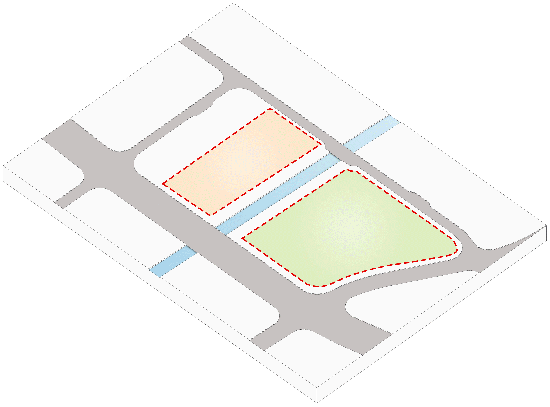查看完整案例


收藏

下载
“摇啊摇,摇到外婆桥……”梦中的童谣在耳畔响起,恍惚间又回到那个水道纵横、阡陌交错的小村落,夹岸绿树结满清甜的果子,乌篷船上的孩子一伸手就能摘到。如今,在这个钢铁和水泥的丛林中,我们更关心下一代会不会得到良好的教育资源,能不能在和同龄人的激烈竞争中脱颖而出,而完全忽视了他们和自然的接触,导致这一代儿童出现了“自然缺失症”。一个偶然的机遇,让我们与滨海小学结缘。我们有机会从校园的自然环境出发,从孩子的活动场所出发,思考教育建筑的切入点。
▼校园运动场,campus sports ground ©赵强
杭州湾新区临于水,生于水,项目用地红线被规划河道一分为二,躲避它还是利用它? 成为设计起始阶段重要的抉择。多番必选之后,我们决定因势利导,将规划河道纳入整个校园的自然核心,最大程度地增加校园的自然景观和活动空间。并对原本笔直的河道进行了调整,使其呈现蜿蜒的形态,在均衡河岸两侧用地同时,留出了可供师生凭栏驻足的港湾,将整个河道及两侧绿带变成校园的中心花园。
▼模型鸟瞰图(左),布局分析(右), aerial view of model (left), layout analysis (right) ©浙江大学建筑设计研究院有限公司
The Hangzhou Bay New District is near water and born from water. The red line of the project land is divided into two parts by the planned river channel. The question of ‘avoid it or use it?’ becomes a significant decision at the beginning of the design. After many required selections, we decided to take advantage of the situation and incorporate the planned river channels into the natural core of the entire campus to maximize the campus’s natural landscape and activity space. Also, we adjusted the original straight river channel to make it meander. While balancing the land on both sides of the river bank, a harbor has been set aside for teachers and students to stop by, and the entire river channel and the green belt on both sides have become the campus’s central garden.
▼校园概览,校园内有一条弯弯的小河 , overview crooked stream on campus ©赵强
为了让阳光照在每个孩子的书本上,在建筑密度较大的情况下,我们将专业教室等功能布置于一层,与虚体的院落和放大的公共区域共同塑造空间的趣味感。而普通教室按年级分栋,坐落其上,营造空间归属感,整个校园由二层平台连为一体。平台之下,曲径通幽。平台之上,肆意奔跑。
▼总平面图(左),院落与平台的联动(右), general layout (left), linkage between courtyard and platform (right) ©浙江大学建筑设计研究院有限公司
To make the sunlight shine on every child’s books, in the situation of high building density, we set professional classrooms on the first floor, together with the courtyard of the virtual body and the enlarged public area to create a sense of fun in the space. Ordinary classrooms are divided into grades and sit on them to create a sense of spatial belonging. The entire campus is connected by a two-story platform. Below the platform, the winding path is quiet. On the platform, children can run wildly.
▼二层平台,通过看台连接平台与运动场, the platform on the second floor, connecting the platform with the stadium through the stands ©赵强
▼二层平台,设有局部升高的小舞台, the platform on the second floor with locally elevated small stage ©赵强
▼连接食堂的二层平台, second-floor platform connected to the cafeteria ©赵强
▼华灯初上的食堂, the canteen at the beginning of the lantern festival ©赵强
▼篮球场与体育馆,basketball court and stadium ©赵强
▼室内体育馆,放大的公共区域被布置在一层, indoor stadium, the enlarged public area is placed on the first floor ©赵强
常言,孩子是纯粹的白纸,虚与空是教育的基础,也是建筑空间的基础。我们将整个基地转化为以水为中心的虚体空间,将湿地、绿化、庭院散落其间。建筑的底层平台和上层的教学主体共同坐落在虚体的格局上,并结合体现江南个性的围墙来区分空间,使整体呈现为一个小河弯弯,庭院深深的院落式校园。
It is usually said that children are pure white paper, vacant and blank and are the foundation of education and it is the foundation of architectural space as well. We transformed the entire base into a virtual body space centered on water, scattered wetlands, greenery and courtyards. The ground floor platform and the upper teaching subject of the building are located on the virtual body structure, which combines with the wall that reflects the personality of Jiangnan to distinguish the space. The whole campus is presented as a deep courtyard with a small winding river.
▼底层院落空间,庭院散落在项目基地上, ground floor courtyard space, the courtyards are scattered on the entire base ©赵强
小学是孩子认知变化最快的阶段,设计从学生的行动力、成长心态等方面着眼,分为三个年龄组团,为其定制符合其年龄特征的低龄、中龄和高龄等三组教学建筑。同时,以小学生的视角来组织空间,控制空间的尺度大小,注重幼儿的体验感受,低龄组的院落更零散和微小,设置较大的集中引导空间,其位置与各功能联系更紧密,使用也更为方便。中高龄组团的院落布置逻辑分明,连接路径清晰,并将两组团相邻布置,便于孩子们的互动和交流。
▼年龄组团分析, age group analysis ©浙江大学建筑设计研究院有限公司
Primary school is the stage where children’s cognitive changes fastest. The design focuses on students’ mobility and growth mentality, and it is divided into three age groups, which customize for the teaching buildings of three groups including low, middle and senior age. In the meanwhile, we organize the space and control the spatial size from the perspective of primary school students, and also we pay attention to the children’s experience. The courtyards of the younger age group are more fragmented and small, with larger centralized guidance space, and their locations are more closely related to each function, which help us to utilize them more conveniently. The courtyard layout of middle-aged and senior-aged groups is set logically, and the connection path is clear. The two groups are arranged next to each other to facilitate children’s interaction and communication.
▼低龄组团庭院空间,设置较大的集中引导空间, elderly group courtyard space with larger centralized guidance space ©赵强
▼中龄组团内院,布置逻辑分明,连接路径清晰, middle-aged group courtyard that is set logically, and the connection path is clear ©赵强
▼中龄组团二层活动平台, middle-aged group second floor activity platform ©赵强
河畔弄青梅,院里骑竹马,童年的记忆总是温暖,设计师希望在孩子们未来的记忆中,对母校的印象仍是承载了无穷欢乐时光的深深庭院,以及那条曾经带走无数小桔灯的弯弯小河。
Playing green plum around the riverside and riding bamboo horses in the yard as well, childhood memories are always warm. The designers hope that in the children’s future memories, the impression of his alma mater is still a deep courtyard that bears endless happy hours, and the winding river that once took away countless small orange lights.
▼艺术中心入口坡道, art center entrance ramp ©赵强
▼教学楼立面图,facade of teaching building ©浙江大学建筑设计研究院有限公司
▼体育馆立面图,stadium elevation ©浙江大学建筑设计研究院有限公司
▼艺术中心立面图,art center elevation ©浙江大学建筑设计研究院有限公司
▼食堂,elevation of canteen ©浙江大学建筑设计研究院有限公司
基本信息 项目名称:宁波杭州湾滨海小学 设计单位:浙江大学建筑设计研究院有限公司 设计时间:2016年8月—2017年1月 完成时间:2017年2月-2019年9月 总建筑面积:47520平方米 地上建筑面积:36180平方米 摄影版权:赵强 客户:宁波杭州湾新区教育发展中心
设计团队 设计总负责人:吴震陵、朱睿 建筑设计团队:王英妮、徐荪、章嘉琛、范真悦、王溯 结构设计团队:金振奋、王俊、李丽、李少华、丁磊、倪闻昊、华旦 给排水设计团队:陈激,陈周杰,方火明,林璐佳,赵洁钦 暖通设计团队:任晓东、郭轶楠、邵春廷 电气设计团队:郑国兴、丁立、孙登峰 智能化设计团队:江兵、张武波、倪高俊、马健 幕墙设计团队:史炯炯、洪抄 景观设计团队:汤泽荣、徐聪花、朱亮、章驰、姚海燕
Basic Information Project name: Ningbo Hangzhou Bay Binhai Primary School Design: The Architectural Design & Research Institute of Zhejiang University Co, Ltd (UAD) Design year: 2016.Aug – 2017.Jan Completion Year: 2017.Feb – 2019.Aug Gross Built Area (square meters): 47520 Ground Floor Area (square meters): 36180 Photo Credits: Qiang Zha0 Clients: Ningbo Hangzhou Bay New District Education Development Center
Design team Lead Architect: Zhenling Wu & Rui Zhu Architecture Design Team: Yingni Wang, Sun Xu, Jiachen Zhang, Zhenyue Fan & Su Wang Structural Design Team: Zhenfen Jin, Jun Wang,Li Li, Shaohua Li, Lei Ding,Wenhao Ni & Dan Hua Water supply and drainage design team: Ji Chen,Zhoujie Chen,Huoming Fang,Lujia Lin&Jieqin Zhao HVAC design team: Xiaodong Ren,Yinan Guo & Chunting Shao Electrical Design Team: Guoxing Zheng,Li Ding& Dengfeng Sun Intelligent design team:Bing Jiang,Wubo Zhang.Gaojun Ni&Jian Ma Curtain wall design team: Jiongjiong Shi& Chao Hong Landscape design team:Zerong Tang,Conghua Xu,Liang Zhu,Chi Zhang&Haiyan Yao










































